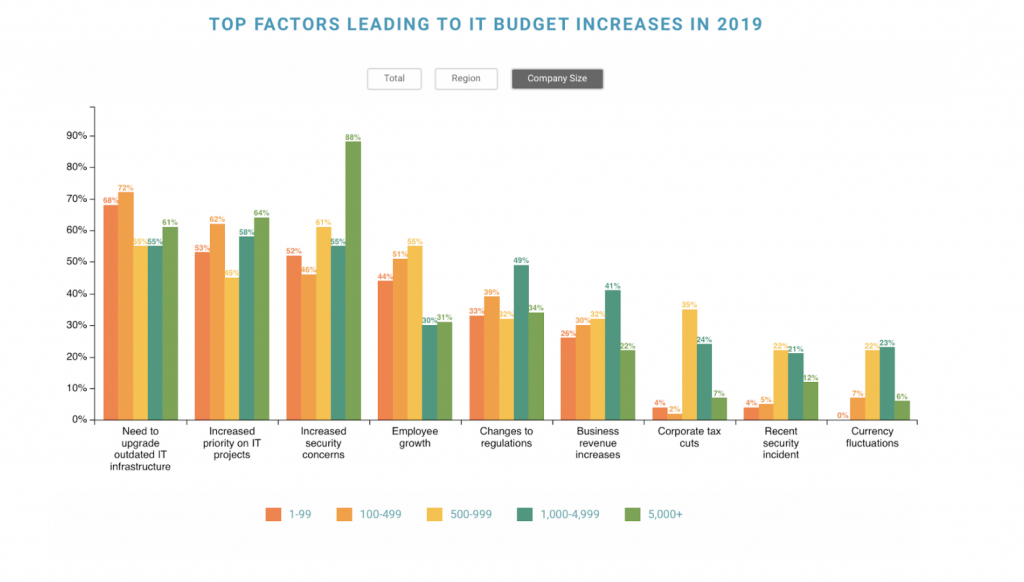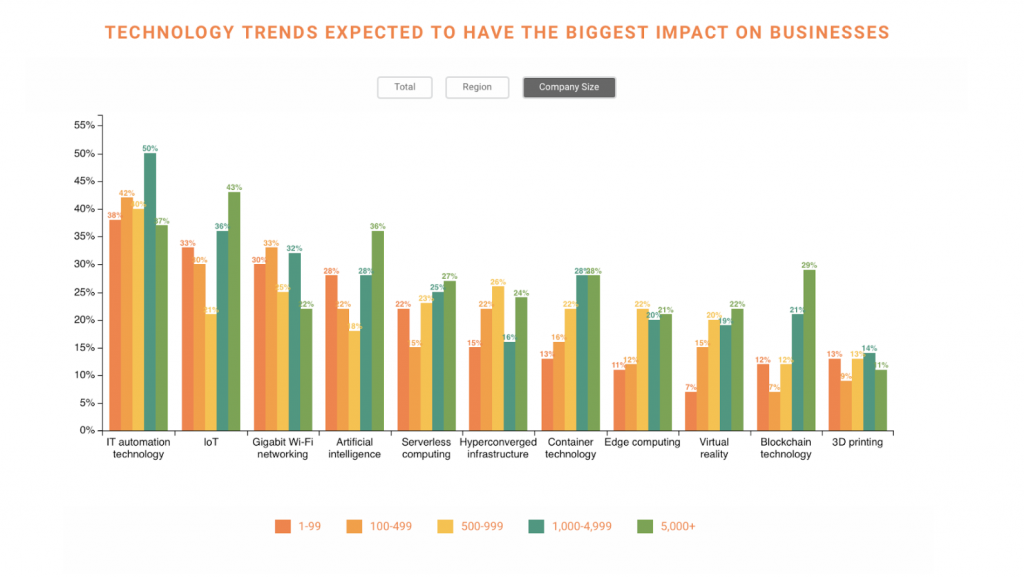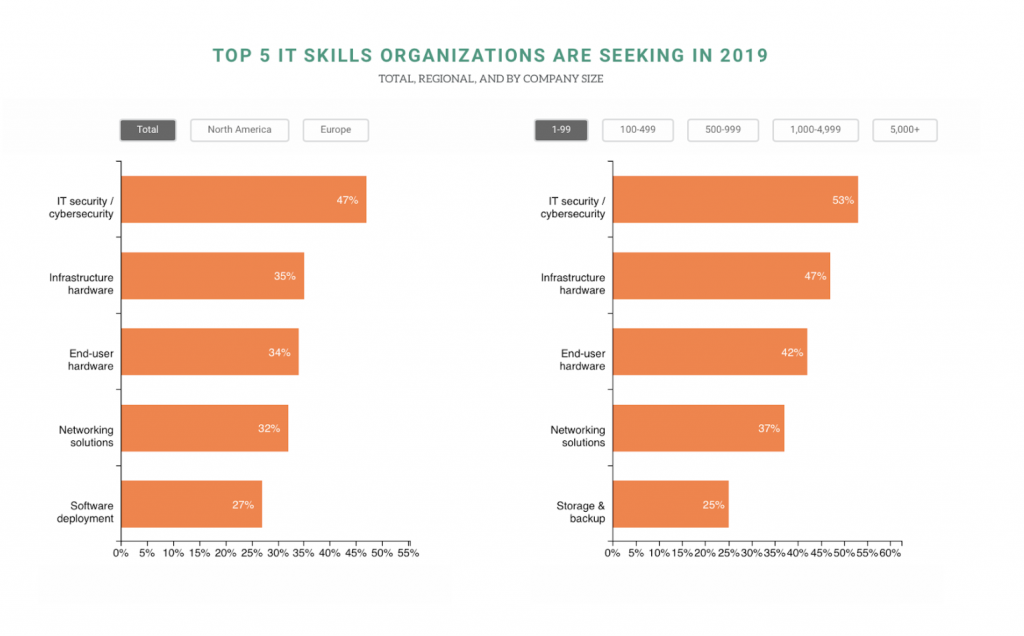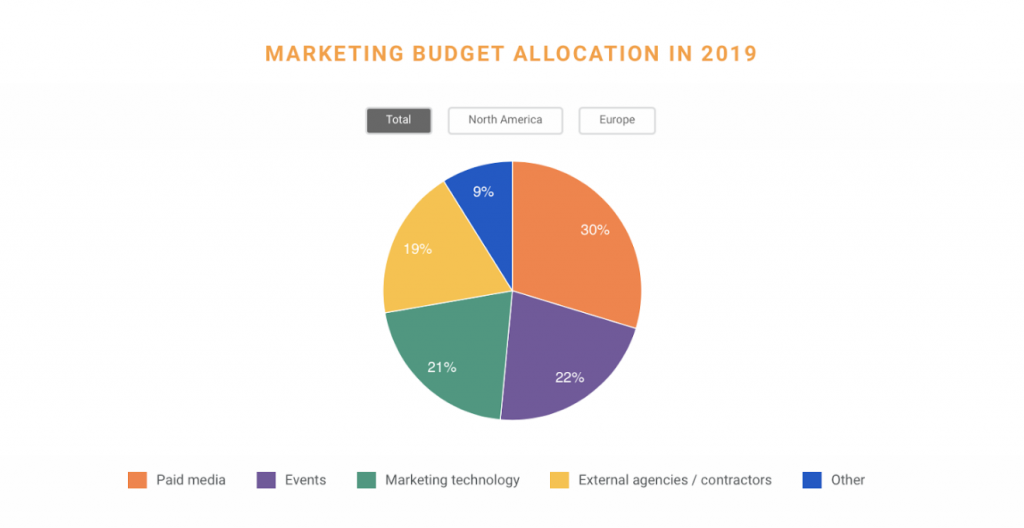
As we head deep into the first quarter of 2019, it’ll be necessary for IT and business leaders to get an overview of what’s expected in the months to come. That’s why we at Digi117 have put together the key findings from Spiceworks’ 2019 State of IT (The Annual Report on IT Budgets and Tech Trends).
The report is based on a survey of more than 700 business technology buyers across Europe and North America. These organizations represented companies of various sizes from industries like education, finance, healthcare, government, manufacturing, non-profits, and much more.
So what can we expect in the tech universe this year? Let’s take a look.
Most Enterprises Expect Their IT Budgets to Grow or Remain Flat
The key takeaway from the report is the fact that as much as 89% of the companies surveyed expected their IT budgets to grow or stay the same this year.
While the factors driving budget increases varied considerably by the size of the organization, 64% of those who were actively planning to increase their IT budgets were doing so to accommodate the upgrade of legacy infrastructure.
When you look at IT budgets considering company size, you’ll find that large companies (as much as 88%) were more likely to increase their budgets because of heightened security concerns. At the same time, 35% of midsized organizations (with 500 to 999 employees) were only interested in increasing their budgets because of corporate tax cuts.
According to Peter Tsai, Senior Technology Analyst at Spiceworks, “most organizations, particularly small businesses, are increasing IT budgets in 2019 to upgrade aging IT infrastructure and support digital transformation initiatives... However, large enterprises, typically with more data and devices to lock down, are primarily increasing budgets due to growing security concerns. With more employees to target, larger organizations recognize the importance of boosting budgets to protect against phishing attacks and avoid potentially crippling malware.”
Companies, that plan to increase their tech budget this year, expect a 20% increase (up from 19% in 2018). At the other end of the spectrum, only 6% of businesses expect to cut back their IT budget (down from 11% last year).
Emerging Tech Will Provide a Competitive Advantage
As technology is evolving at lightning speed, businesses that take advantage of new IT offerings have the potential to be ahead of the competition. This is probably why 61% of companies surveyed stated that they plan to leverage gigabit WiFi networking technology by 2020.
Another 57% expected to benefit from IT automation while 48% planned to incorporate the Internet of Things (IoT). About 39% of companies were also preparing to deploy converged or hyper-converged infrastructure while another 35% expected to leverage serverless computing microservices. About 38% of companies surveyed are expected to utilize application-isolating containers.
What was surprising is the fact that technologies like 3D printers, Artificial Intelligence (AI), the blockchain, edge computing architectures, and Virtual Reality (VR) weren’t going to hit the mainstream by 2020. Less than a third of the organizations surveyed had adopted or planned to adopt these new technologies.
Even though adoption rates will be slow, these new technologies are still poised to play an important role in certain types of companies. For example, compared to smaller businesses, large enterprises were more likely to deploy emerging technologies because they have the resources to do it.
This is why AI adoption is ten times higher in large enterprises compared to their smaller counterparts. Only 3% of smaller companies with fewer than 100 employees use AI compared to 31% of large corporations with over 5,000 employees.
When it comes to the blockchain, something similar is going on as only 5% of small businesses are currently taking advantage of it compared to 25% of large enterprises.
By 2020, large enterprises also plan to deploy certain technologies at a significantly higher rate than the global average:
- Containers - 73%
- Edge computing architectures - 65%
- IoT - 85%
- Hyper-converged infrastructure - 72%
- Serverless computing - 61%
- VR - 61%
European companies are leading their North American counterparts when it comes to the adoption of emerging security solutions. This can be attributed to the General Data Protection Regulation that came into effect last May.
European businesses also seem to be taking this opportunity to adopt emerging technology. In fact, they’re twice as likely to adopt new technology than their North American counterparts.
Demand for IT Skills Will Continue to Rise
Spiceworks surveyed 1,000 IT professionals across Europe and North America and found that tech professionals were looking to take their careers to the next level. Companies of all sizes continued to fill vacancies, and this is evidenced by the plans of one in four enterprises (or 29%) that were looking to increase their IT staff this year.
Only about 5% of companies planned to reduce the size of their IT department this year. About 59% expected their IT departments to remain the same. However, this doesn’t mean that they won’t be hiring anyone this year. Instead, hiring will probably occur due to turnover.
Highly experienced IT professionals and millennials are expected to seek new opportunities this year to benefit from better salaries and opportunities to advance their career. The key takeaway here is that 26% IT professionals will seek a new employer, 6% plan to move on to consulting, 5% plan to retire, and 8% hope to switch careers (and leave IT behind).
According to Brian Slater, Founding Partner of Eikos Partners, “many companies are facing challenges retaining employees with traditional IT expertise, so they’re not able to increase their IT staff when they’re focused on filling in the gaps after IT pros leave. Companies that do plan to increase staff are often targeting specific IT skills rather than general expertise.”
When it comes to expertise, most companies are after security experts to better secure their enterprise IT infrastructure. However, large companies with over 5,000 employees will also be looking for AI professionals.
Midsized companies (with 500 to 999 employees) are expected to be on the lookout for DevOps professionals. Smaller organizations are expected to seek end-user hardware and infrastructure expertise.
B2B Tech Brands Are Increasing Their Marketing Budgets
A survey of more than 350 B2B marketers in technology companies saw a positive future for their marketing initiatives.
Almost 80% of organizations expected their marketing budgets to grow or remain the same this year. This can be attributed to their focus on new customer acquisition while sustaining positive momentum.
As much as 37% of businesses also expected to see a significant increase in their marketing budget this year. If we breakdown the marketing budgets, about 30% will go towards paid media efforts, 22% for trade shows, and 21% for martech. Approximately 19% will be allocated for external agencies and contractors.
While paid media is expected to account for the biggest spend their year, martech budgets saw the most significant increase year on year with 51% of enterprises expected to spend more this year than in 2018.
On the other hand, external agencies, contractors, and trade show budgets were highly unlikely to see a year over year increase. Instead, its expected to remain the same or decrease in 2020.
Adoption of AI-powered data analytics, influencer marketing, and purchase-intent targeting are expected to experience a rise in adoption over the next two years. As much as 44% of businesses will use AI-powered data analytics tools, 51% will utilize influencer marketing, and 48% will leverage purchase-intent targeting.
By the end of next year, 71% of companies are also expected to use video marketing to deliver entertaining content, share customer testimonies, and live stream events.
As you can see from the above, the state of IT in the western hemisphere is not only healthy but also evolving rapidly.









